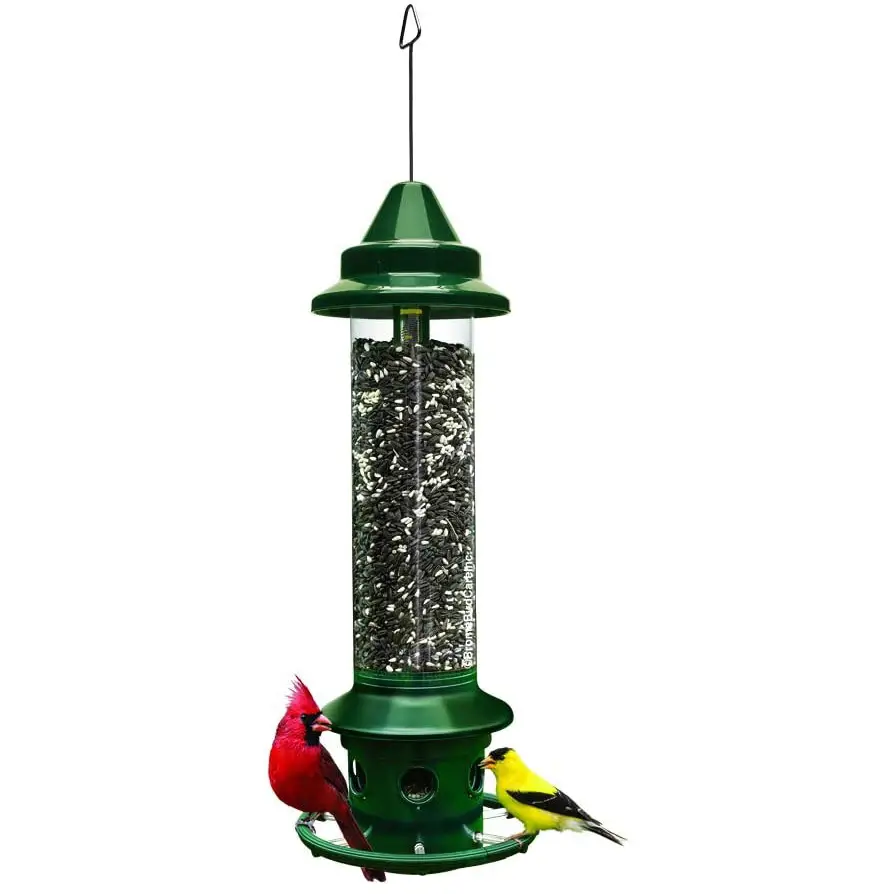
- Brand Brome
- Color Garden green
- Material Polycarbonate
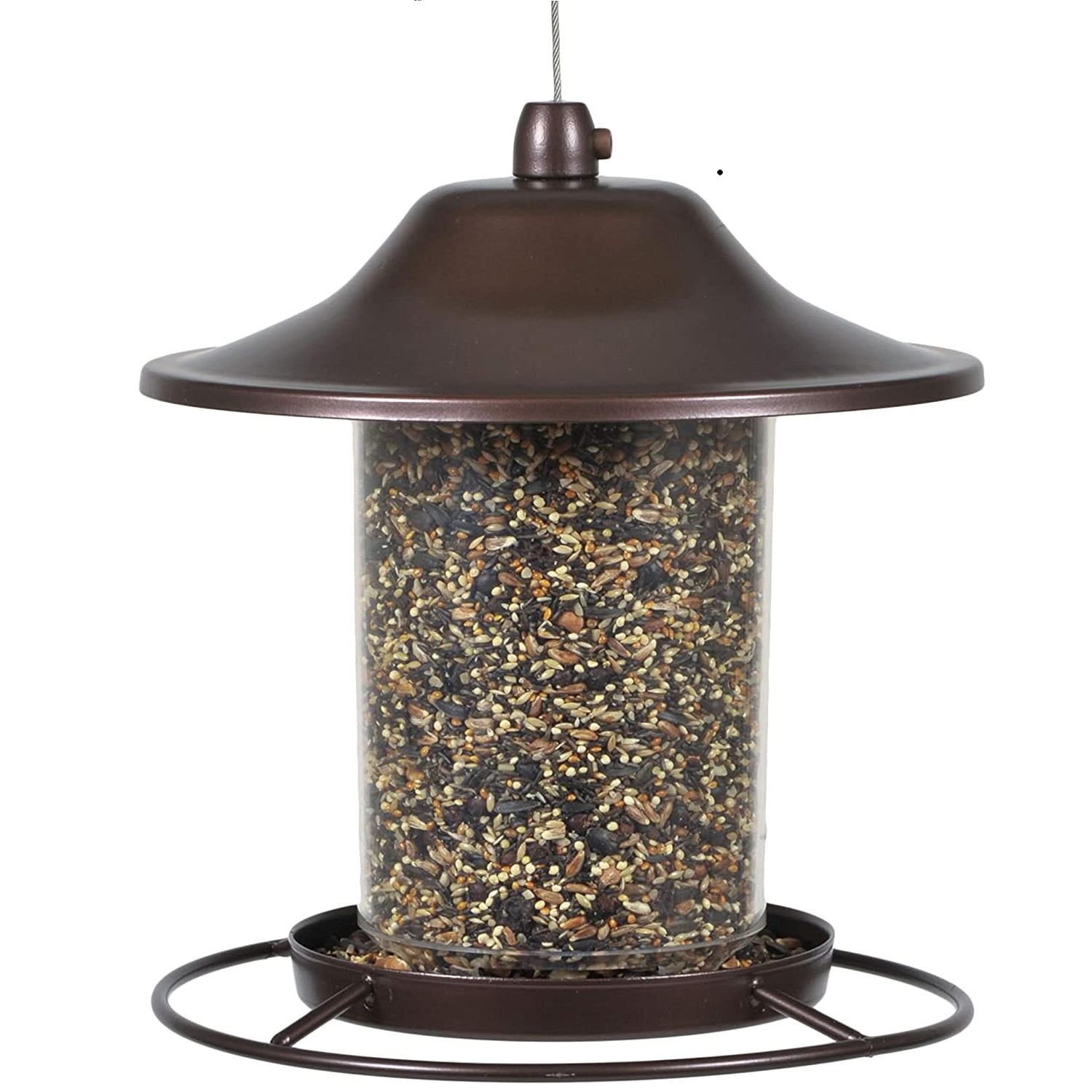
- Color: Brown
- Brand Perky-Pet
- Material Plastic
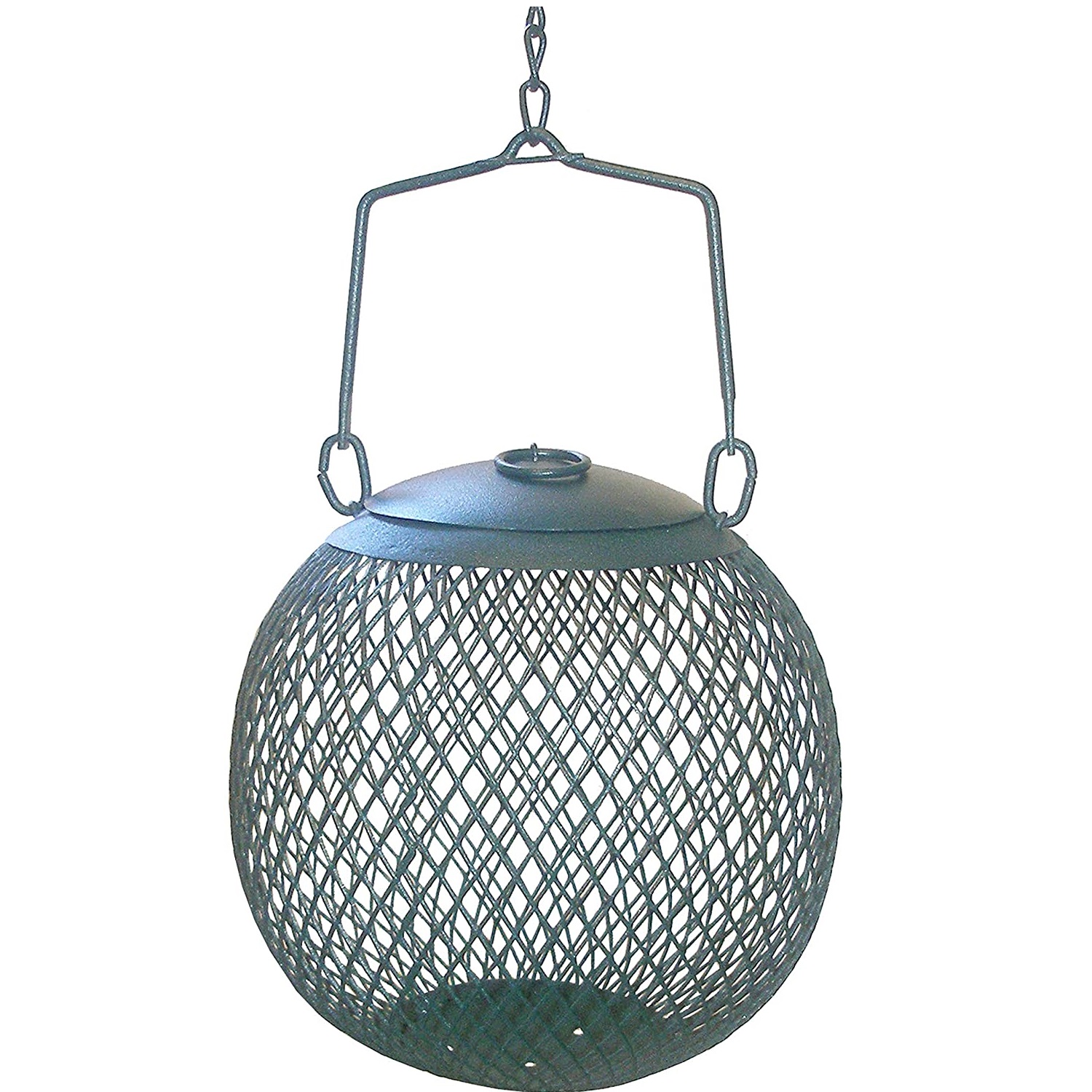
- Brand Perky-Pet
- Color Green
- 5.4 x 5.4 x 5.4 inches
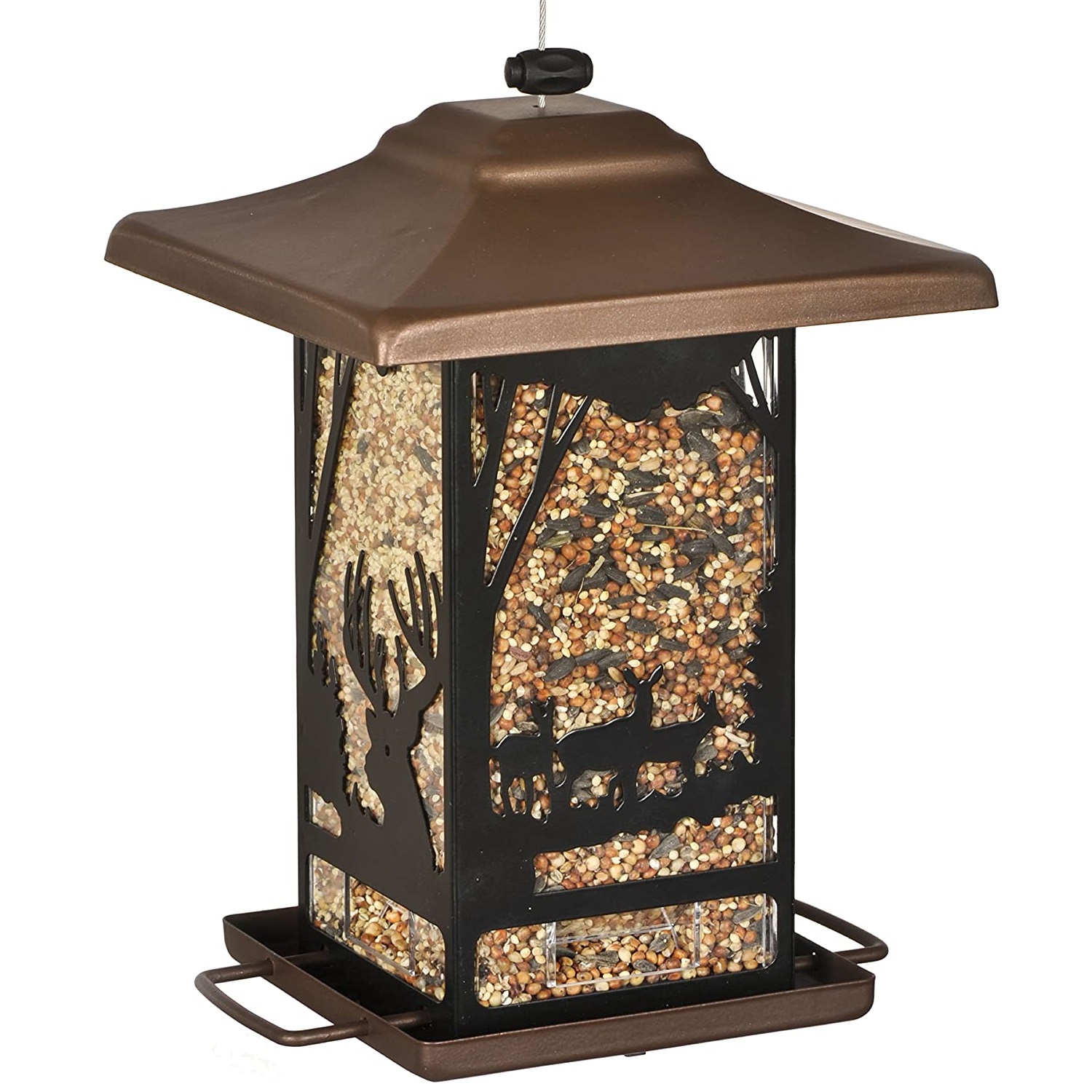
- Brand Perky-Pet
- Color Brown
- Material Metal
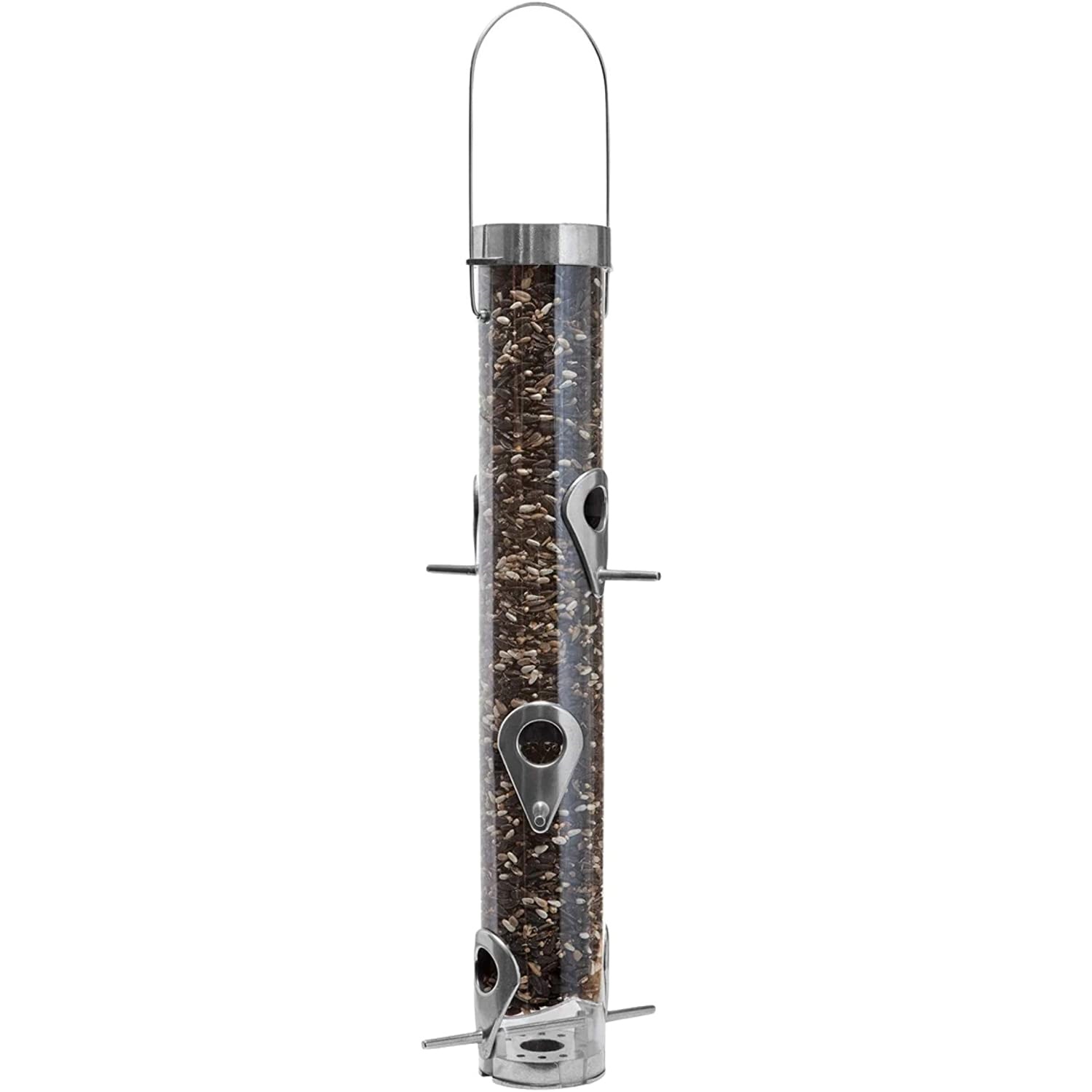
- Brand Droll Yankees
- Color 16-Inch
- Material Metal
Choose the Best Bird Feeder
Customer’s Choice: the Best Rated Bird Feeders
2 users answered this survey. Please help us improve this review!
A bird feeder is a device, often made of plastic or metal that stores and dispenses seeds for birds. The most common type of bird feeder consists of a wire cage with perches inside the enclosure. The seed will be inserted in various places on the outside of the cage to attract the desired species.
There are many different types of seed available such as cracked corn, millet, sunflower seeds, and more specialized mixes (black oil sunflower mix) that offer an appealing source for feeding along with attracting all kinds of birds coming around your yard!
The benefits of bird feeders are plentiful. They offer natural, healthy foods for birds and increase the odds that you’ll have a close-up experience with your favorite winged creatures. There’s no need to wait all winter for spring migration – they’re right outside your window if you provide them some easy opportunities to find food in warmer months too.
If you’re looking for the best bird feeders and want to know more about what they are, how to choose them, and how to use them, then this is the article for you. This guide includes tips on how to make your yard a haven for birds of all shapes and sizes.
Table of Contents
Squirrel Buster Plus Squirrel-proof Bird Feeder w/Cardinal Ring – the Editor’s choice!
 This Squirrel Buster Plus feeder is a witty way to feed the birds. Lovingly designed and handmade with meticulous attention to detail, it’s a beautiful addition to your backyard retreat. Crafted from aluminum and powder-coated using non-toxic paint, this feeder will stand up to rust forever while feeding 2 weeks of seed at a time.
This Squirrel Buster Plus feeder is a witty way to feed the birds. Lovingly designed and handmade with meticulous attention to detail, it’s a beautiful addition to your backyard retreat. Crafted from aluminum and powder-coated using non-toxic paint, this feeder will stand up to rust forever while feeding 2 weeks of seed at a time.
Features include weight adjustable compartments, patented seed ventilation system for fresh seeds longer – attracting more wild birds than ever before!
With an 18-inch clearance all around, it’s super easy to hang and offers safe feeding to wild birds with its chew-proof material. This bird feeder is truly squirrel-proof – if you can’t see seed inside the housing, then the weight of an adult squirrel has closed the shroud denying access to seed.
Being weather-resistant up to -4 degrees Fahrenheit, this sturdy feeder comes complete with a cardinal ring that will reliably attract Northern Cardinals into your yard year after year.
The Squirrel Buster Plus will give you a lifetime of care for this unit. The patented design is chew-resistant and provides your family with food all year long. With the bonus of attracting cardinals, this feeder will keep everyone happy.
This feeder is well-designed for durability and will last all year long no matter how many times it’s tipped over by an ambitious squirrel.
Perky-Pet 1 312 Panorama Bird Feeder – the best for design!
 All birdies want a Perky-Pet 1 312 Panorama Bird Feeder. Shaped like a cozy round nest, the seed tray and circular perch let birds of all sizes feed on all angles! With an easy-to-fix cable for versatile placement, it’s perfect to hang in the shade of trees or under window ledges.
All birdies want a Perky-Pet 1 312 Panorama Bird Feeder. Shaped like a cozy round nest, the seed tray and circular perch let birds of all sizes feed on all angles! With an easy-to-fix cable for versatile placement, it’s perfect to hang in the shade of trees or under window ledges.
This bird feeder has a large opening for easy cleaning, but the Sure-Lock cap locks the lid in place to ensure that annoying squirrels stay off your food. Inside there are two seed trays with circular perches. Whether you’re looking for an easier way to clean up or just want more birds at your house this year, the Perky-Pet 1 312 Panorama Bird Feeder should be perfect.
This feeder can be used with any type of birdseed and has a large opening for easy cleaning. It also includes a built-in hanging cable making it more versatile.
Perky-Pet GSB00344 Seed Ball Wild Bird Feeder – the best for easy maintenance!
 The Perky-Pet GSB00344 Seed Ball Wild Bird Feeder is the perfect way to add cheer to your yard. This product features unique mesh wire design and provides birds with easy access to food.
The Perky-Pet GSB00344 Seed Ball Wild Bird Feeder is the perfect way to add cheer to your yard. This product features unique mesh wire design and provides birds with easy access to food.
The feeder also has a patented, green finish that looks beautiful in any garden space. Birds can clench on the surface and not worry about water pooling at any point of the storage container – this ensures fresh seed for an extended period.
You’ll love how easy it is to feed your birds this season with this Perky-Pet bird feeder. It features a unique mesh wire design and provides the perfect feeding area for a variety of clinging birds. The feeder is low-maintenance, easy to clean and is sure to keep birds happy all season long.
Perky-Pet 8504-2 Wilderness Lantern Bird Feeder – the best for style!
 The Perky-Pet 8504-2 feeder is great for a unique bird watching in your garden. It holds up to 2 pounds of seed and features a patented sure-lock cap system that helps keep squirrels out and seed-saving drain holes.
The Perky-Pet 8504-2 feeder is great for a unique bird watching in your garden. It holds up to 2 pounds of seed and features a patented sure-lock cap system that helps keep squirrels out and seed-saving drain holes.
The main feeder has a metal base with an oval opening at the top that’s perfect for perching while eating. There are also 4 headless hooks so you can hang it from tree limbs or branches. This lantern feeder comes finished with red, yellow and cinnamon scrollwork and includes two 3W utility bulbs (60 Lumens each). With its smaller size, this allows it to be put on tables near patio furniture as well!
This charming Perky-Pet feeder features uniquely designed home accents including an all-metal perch, copper seed ports and vintage lantern styling that covers any lawn.
Droll Yankees A-6RP Classic Ring Pull Feeder – the best for feeding many birds at once!
 The Droll Yankees A-6RP feeder can be the perfect feeder for your backyard bird-watching needs! This 16-inch classic ring pull feeder has a UV-stabilized polycarbonate tube to see how many birds visit and 6 feeding ports for a large handful of seeds.
The Droll Yankees A-6RP feeder can be the perfect feeder for your backyard bird-watching needs! This 16-inch classic ring pull feeder has a UV-stabilized polycarbonate tube to see how many birds visit and 6 feeding ports for a large handful of seeds.
Add 1 pound of seed and you’ll have 6 ports for birds to feed on without the competition of squirrels. The polycarbonate tube has an easy-to-clean ring pull advantage that makes disassembly hassle-free without breaking your nails on metal parts like other feeders cause.
The wire hanger makes it easy to install in a tree or from a pole, and an included stainless steel wire-mounting clip allows you to hang it out of the squirrel’s reach. The Droll Yankees lifetime warranty against squirrel damage will protect your investment from annoying rodents.
This Droll Yankees A-6RP Classic Ring Pull Feeder is a durable feeder with 6 ports that the squirrels will never chew on thanks to its patented design.
The Buyer’s Guide
Types of Bird Feeders:
1) Ground
Ground bird feeders are perfect for attracting a variety of ground-feeding birds, including sparrows, finches and grackles. They can also be used to feed larger animals like deer or raccoons which would otherwise destroy the other types of the birdfeeder.
Ground feeding requires more frequent filling than others because it is on the ground where food attracts pests such as insects who then consume most of what has been put out by either type. The best option is when you have some sort of shrubbery in your yard that will provide good coverage from predators while still allowing easy access for the birds. This way they don’t worry about hiding behind bushes so much and can get into their natural feeding pattern easier without feeling scared all the time.
Ground feeding birds will eat a wide variety of seed-based foods, but they also enjoy eating suet mixed with seeds and fruit as well so it is important to mix up the different types in order to attract more interest.
For example, hanging bird feeders allow for easier filling because you don’t have to bend over every time you put food out while still providing good protection against predators depending on what sort of tree it’s attached to (trees near houses tend not to offer enough coverage). Raised models make refilling easy without having to crouch down at all times yet provide less cover than those that are hung.
When you have a ground feeder, it is important to keep the food fresh and free of pesky pests by using a bird feeder protector such as a dome-style suet cage or one that hangs from your tree branch. These protectors will ensure birds can enjoy their food without being bothered too much.
2) Tube
Tube feeders are typically made from lightweight metal like aluminum. They come in a variety of shapes and sizes – some have perches for birds to sit on while they eat or drink. Some tube feeders also feature an attached platform that’s perfect for hanging birdhouses before the winter months hit (birds will spend more time near their nesting spots during cold weather).
The best part about these types of feeders is you can put them just about anywhere without worrying too much about stability since it hangs rather than sits on the ground. And if squirrels start getting into your seed, then this type of feeder has got you covered because there are usually holes at either end with wire mesh over the top so critters can’t get at the food.
Some tube feeders are also designed to offer a different type of challenge for birds. Some have perches that spin around, while others may be slanted or curved in various ways. The important thing is that there’s more than one way for any bird (or squirrel) to find something they like about the design.
Many people who use these types of feeders recommend using suet cakes as well because it helps keep seeds dry and protected from rain or snow during long periods without being refreshed. This can help you save both time and money since you won’t need to worry so much about constantly refilling the tray with fresh seeds every day.
3) Hopper
A hopper-type feeder is a great choice for bird lovers who want to attract and watch birds of all sizes. These types hold large quantities of seed, so it’s perfect if you want to see lots of different species at your home. The design also makes them easy to refill with fresh food when necessary–but the downside is that they’re not as attractive in the garden or on patios due to their big size.
They can be less messy than other styles because seeds spill straight from one level to another instead of collecting at each perch where many small birds will congregate together looking for treats – making cleanup easier too. Hoppers are generally made out of durable plastic materials and come in various shapes including cylinder-shaped, dome-shaped, and round.
4) Suet
Suet bird feeders are made of suet – a hard, fatty substance that birds enjoy. It’s typically found in the form of blocks or cakes and can be mixed with other ingredients like peanuts to attract more species. You will also find it at some types of restaurants where people might go for breakfast – that way they don’t need to worry about feeding their backyard visitors! They come in different shapes and sizes but you want one that has openings smaller than an inch so small tree-dwelling animals won’t get into them. The best thing about these types of feeders is since they’re not filled with seeds, the ground below doesn’t become covered in spilled seed during heavy winds or rainstorms making cleanup easier.
5) Thistle
Thistle bird feeders are more expensive but they last a long time. The seeds can’t escape easily, so the birds will be able to eat throughout winter without wasting any of them. There is also little chance that other animals could get into your food supply and eat from the ground up this way. This means you might not have to replenish as often as with other types of feeders, saving you money over time. They’re also very cute-looking on trees or bushes near your house because of their open design.
6) Nectar
Nectar bird feeders are a great option for attracting hummingbirds. They can be hung from trees or mounted on poles and posts, but they’re not ideal if you have other types of birds in your yard as well because the red flowers will only attract hummingbirds to visit.
Make sure that there is plenty of nectar-like sugar water nearby so these beautiful creatures don’t fly away before feeding. Be careful using this type of feeder on cold days since it may freeze up causing the food source to be inaccessible at times.
Bird Feeder Materials
Different bird feeder materials can give you a different experience. A metal one might be more durable than the wooden ones that are more sensitive to changes in weather conditions and temperature fluctuations. The plastic ones, while being cheaper, usually don’t last as long unless they’re high-quality plastics such as polycarbonate or acrylics that have UV protection (plastics without these features will break down relatively quickly).
What’s your budget? If it’s higher then go for a quality wood feeder with thick sides for added insulation from the elements in wintertime. There is also an option of buying two – one for summer use and another for wintertime. This way you’ll save money on replacements when there are harsh winters where squirrels can access your feeder.
Wooden ones can be either bought unfinished (where you may need to seal and treat them yourself) or pre-assembled. If the latter, then they’re usually made of pine that is a softwood that doesn’t last as long and needs more care when handling because it scratches easily.
Metal ones are a cheaper option but also require some maintenance such as rustproofing if left outside for extended periods in high humidity areas with no protection from rainwater runoff.
For those who can’t decide between a metal or wooden one, the latter is more energy-efficient and emits less heat which is good for birds during summertime.
Bird Feeder Installation
Installing the feeder and making sure it is secure will help keep squirrels, raccoons and other critters out of your bird food. Use a metal pole with a bracket to attach the feeder securely to an outdoor surface such as a fence or post. The bolts should be tightened down firmly for best results.
You can also use wire mesh (or even chicken wire) over an existing structure like branches on trees – this prevents larger birds from taking up more space than smaller songbirds but still lets them eat! Make sure you clean off any residual dirt before adding seeds so they don’t clog the feeding ports.
If you are installing multiple feeders in close proximity, make sure that each feeder has its perch. Birds will fight over the same perch and this could lead to injury or death for a bird who falls from the perch in order to get more food.
Some feeders have built-in baffles that keep seed dry, safe from squirrels and inaccessible to other critters (like raccoons). These can be great if you want something easy – but make sure they are installed securely so it doesn’t tip over easily.
If you’re looking for an uncluttered option without any metal parts, try using simple glass jars with wire mesh on either side of the mouth. This also makes them easy to clean out after use because your hand fits inside nicely and there are no nooks were seeds might collect.
To create an ideal, natural environment for songbirds, you can also try some houseplants to feed them from. Houseplants provide shelter and cover during the winter months when food is scarce – so birds have somewhere to eat and make use of on cold days. Birdseed (or suet) works best in this scenario because they are less likely than other animals to be interested in it (like raccoons or squirrels), but still accessible enough that small birds can find their way inside the jar.
You may need additional protection if your location has an abundance of predators like coyotes or foxes around. There are many products available at pet stores designed specifically as animal deterrents. These come with different levels of effectiveness.
When it comes to different types of bird feeders, you have a lot to choose from! The easiest type to assemble and install is the hopper or tube feeder. These are usually made out of plastic and come in many sizes. It’s easy for birds to fly up close without risk because they can’t be attacked by larger animal predators as easily this way.
Some other options include platform perch, hanging/adhesive window cling, suet hoop feeder, tray table top feeder, etc. You also want one that has at least three feeding ports so more than just one bird can eat at once. Be careful about making your own when installing metal parts that might not hold down squirrels, raccoons, etc.
A great way to keep your feeder stocked with fresh food is by making sure you fill it up every few days. It’s a good idea to set aside some time each week for this task so there are always seeds available when the birds need them.
If possible, try not to refill in windy conditions because much of the seed will blow away before they can eat.
How to assemble a bird feeder?
Some bird feeders come assembled and ready to go out of the box. If your purchase does not include assembly instructions, fret not. Putting together a bird feeder is simple – no tools or experience required (though it may be best for an adult).
First, you should find two sturdy chairs or something similar that will allow you to reach up high like a ladder. Make sure they are stable so as not to fall over while in use. Place them next to each other facing away from one another with enough space on both sides so you can move freely between them.
Then place the top half of your chosen bird feeder onto the chair closest to you at about hip height where there’s ample room beneath it before placing the base on the other chair. Next to the birdfeeder’s top, you should have a small piece of wood or something heavy like a brick under it in order to keep it balanced as you work.
Next, bring one side of the feeder up and onto your shoulder before carefully balancing it with both hands so that you’re supporting its weight while avoiding contact with any part of your body not covered by clothing. Bring this arm up first and then pivot until you’ve got enough room between chairs for your free hand to reach out high enough (without bumping into either chair) so that when opened, they are parallel at about head height. Now place an end over each shoulder – right over left is best if using two hands isn’t an option.
Tighten the screw in both ends to tighten it up and make sure nothing’s loose before proceeding as you just need to do this once or twice at most. If your new feeder is tube style, first assembled by placing one end of the two tubes into each armhole so that they’re perpendicular when looking from above.
Next, place each tube over its corresponding shoulder and hold with one hand while tightening screws on either side with the other. You can then remove these spindles for easy storage later if desired.
What you need to install a bird feeder:
- Nails;
- Screws;
- Brackets (to hang from a tree);
- Hooks to hang the feeder from an outdoor hook. If installing hooks, make sure they are securely mounted and stable enough to support their weight;
Hanging your bird feeders at eye level will allow for easy viewing by birds but out of reach for annoying squirrels. The majority of people hang their bird feeders about two feet off the ground in order to comply with this standard height range.
How to hang a bird feeder?
This will vary depending on the type of feeder. Some birds, like Cardinals and Blue Jays, need something with a lot of depth for them to reach in and out without being too high or low off the ground (between 20-40 inches). So it’s important that they have enough room inside to grab their food.
The best way to do this would be mounting your birdfeeder from a tree limb rather than attaching it directly onto a post – so long as you are sure there is plenty of space above where you’re hanging it because many species don’t fly much higher than 20 feet up into trees. Other types of feeders won’t require that much depth and can be mounted on posts or even on a balcony railing.
Some more tips for hanging bird feeders:
- Before you put any type of suet cake out, cover it with cheesecloth to keep the birds from getting sooty when they land in order to eat the food. This is especially important if there are grills going nearby because the smoke will really stick to their feathers;
- If your post has branches that come up close enough below it (within 2 feet), try mounting your feeder onto one of them rather than just directly onto the pole itself – this way you’re not intruding too far into their territory since many small songbirds won’t like having something between themselves and their food;
- Avoid using a lot of metal in your area, since birds can get harmed from the sharp edges or even electrocuted by coming too close to power lines (or whatever is connected to them);
- Hang the bird feeders about 4 feet off the ground so that they are not easily accessible for cats and other predators. That way you’ll also be able to enjoy watching what happens below without having to worry about their safety – though if you have any concerns, just put up wire mesh around it;
- If possible, avoid hanging bird feeders near houses with reflective windows because this will scare away many types of smaller songbirds such as Wrens and Warblers who won’t want anything between themselves and potential predators;
Bird Feeder Cleaning
It is important to keep bird feeders clean, so the birds will continue coming back for food. Regularly take care of your feeder and you should not have a problem with pests like rats or mice being attracted to it.
Cleaning a bird feeder can be done in three ways:
- Wear old clothes. This prevents bird droppings from getting on your clothing and then being brought into the house. You don’t want to contaminate food or surfaces with bacteria that could make you sick, so it is important to avoid these substances in the household;
- Use a natural cleaner like vinegar to kill any bacteria left over from birds visiting the feeder earlier in the day. Vinegar does not leave behind any chemical residue which can irritate sensitive human skin, while it also helps deter pests such as mice and rats who are looking for an easy meal source near homes where children live indoors. I recommend diluting white distilled vinegar by half with water before spraying down areas of the surface that cannot be cleaned well with a brush, like the poles;
- Put on rubber gloves and use soap to scrub any tough stains or crusted bird droppings off with a nylon bristle brush if you feel that it is needed. Make sure to rinse everything very thoroughly before letting water drain out of your feeder for good measure. Remember not to wet anything below one foot in height so as not to cause an electrical hazard from when water sits near outlets and wiring nearby;
Also, you may use a solution of one part vinegar or lemon juice with four parts water in a dishpan on the ground near the feeder. Dip an old sponge into this solution and then scrub all surfaces clean before rinsing off any liquid that drips onto soil because the strong acid can damage plants close by.
The main cause of mold and mildew is the buildup of sticky substances like sugar or molasses, which can be removed by a thorough scrubbing with soap and water. That is why the bird feeder surfaces should then be rinsed thoroughly in running water before refilling your feeder.
You can clean a bird feeder by taking off the perches and removing any seed that has collected on them, as well as seeds from underneath. You should also remove old food particles that have been sitting around for too long; bacteria will grow in this area if not tended to. Then you can either use hot soapy water or dish detergent with lukewarm water (never scalding) to scrub it down until it is nice and shiny again.
Tips for users: never soak your bird feeders in anything other than warm/lukewarm water – birds are very sensitive little creatures who cannot handle having their feathers wet.
FAQ
Do bird feeders attract rats?
Many people are wary of feeding birds because they believe bird feeders attract rats, but this is not true. Rats will only eat food that humans prepare for them and many don’t like the taste of seeds or grains.
Even if a rat does come to a feeder, it doesn’t usually stay long enough to get any sustenance from it before moving on in search of more reliable sources – so you can rest assured your local rodent population probably won’t be too happy about all those hungry mouths looking at their territory!
It’s important to keep your seed as fresh as possible though by replacing what you use each day with new bags (typically most brands have ten pounds). This ensures there are always plenty of tasty snacks available for hungry feathered visitors.
Which birds eat from tube feeders?
Many types of birds eat from tube feeders. Some common ones include cardinals, blue jays, chickadees, finches and nuthatches, to name a few.
However, it’s important not to fill the tube feeder with all your favorite bird food in one go. Some people mistakenly believe that they have done enough by filling their tube feeder about halfway up (roughly two inches) with seed or suet pellets – this is actually way too much for any given type of animal.
Birds can’t really choose what they want out of the supply you provide them if there’s just so much piled on top. As well as being wasteful, spoiled seeds will also spoil the other food sources in the feeder because no air circulates inside. The best thing to do is to give the birds a few inches of space at the top, and then fill it with new bird food so that they can eat as much or as little as they need.
What type of bird seed attracts the most birds?
Some of the best bird seed mixes for attracting a wide variety of birds are black oil sunflower seeds, shelled peanuts in red shells, cracked corn (yellow & white), whole corn kernels, and hulled safflower. Peanut butter can be mixed with these ingredients to attract cardinals.
The best way to attract birds is by providing a variety of food for them. Different species have different preferences, so it’s important to provide as many choices as possible.
Birds often find bird feeders with dropped seeds less attractive than ones that are constantly refilled and always fresh-looking because there won’t be enough time between visits for the seed particles to dry out before more arrive on the ground. If you don’t want your lawn turned into an unsightly mess then try scattering breadcrumbs around these areas instead or use some other type of ground cover such as mulch or bark chips under the feeder stand or platform.
How can I attract more birds?
The best way to attract more birds is by using a mix of bird seeds in various feeders.
Here are some tips on how to use the different types:
- Put out two or three smaller feeders that can be used for seed and peanuts so small birds can easily access them. These should be no more than 12 inches off the ground;
- Make sure there’s plenty of food, preferably in many different shapes and sizes. That means putting out sunflower seeds, suet cakes, peanut butter cups with holes cut into them, whole peanuts, corn kernels, pumpkin seeds and cracked corn. Try not to put out just one type at any given time – this will result in only certain species coming around while others go hungry;
- Wet cracked corn is especially good for sparrows, chickadees and titmice – put out a water source as well so they can bathe while dining;
- Put up one or two hopper feeders high in the trees to attract blue jays, woodpeckers and nuthatches. These should be around 20 feet off the ground with no perches below them because these birds will not go to feeders that are easily accessible by predators such as cats;
- Supplement your feeding station with birdhouses scattered throughout your yard. This way you’ll also have plenty of nesting sites available for new arrivals who come along looking for a place to call home (which could get quite crowded if all those homes are within a single feeder);
Why do birds not like my feeder?
Some birds are more particular than others are. Some prefer a seed feeder, some like a suet-type feeder, and still other birds may want to land on the ground for their meal instead of perching at eye level.
The best way to get your desired bird to visit is by providing what that specific species prefers: different types of seeds or suet cakes in various sizes and shapes. And you can also put out bread crumbs as an alternative when there’s not much else available (and it will also attract mice).
There are many different kinds of birds and they vary in size so if you have a tree nearby that doesn’t require any climbing then it will likely attract more species than one on top of your house might. If there isn’t anything nearby for them to perch on, they may not want to come.
It also helps if you put something at eye level (like a branch) near their preferred type of feeding area like an open window so that when they fly by looking for food, see what looks good to eat, and land right away with no effort needed.
What do you put under bird feeders?
A few things that you can put under your bird feeders to keep the food from getting wet, dirty, or eaten by other animals. These include gravel pads and crushed oyster shells, which will help protect surfaces below them. If these aren’t available then there is always sand, mulch, or straw on hand to fulfill this purpose as well.
There is no need for a lot of depth with any of these items; just enough so that birds have somewhere dry and comfortable to sit while they eat their seed mix!
Don’t forget about the grates. Grate inserts not only attract squirrels away from your birdfeeder but also allow small songbirds such as finches and cardinals to perch on the grate and eat.
You can also put a grated platform feeder in another location, such as your porch railing or balcony for more bird watching opportunities! You may need to use netting if you are trying to keep larger birds from accessing it though.
What time of day do birds feed?
Birds are opportunistic feeders who will eat when they have the chance and foraging conditions allow. They don’t necessarily plan their day according to a schedule, so it’s difficult to answer this question with complete accuracy.
However, there has been some research done that shows birds often tend to be more active in the morning hours before 11am than any other time of the day or night, especially during springtime migrations. If you’re not sure what type of bird is visiting your yard at any given moment, try offering food around sunrise and see if anything nibbles!
Most birds feed all day long, but most often in the morning and evening.
Do birds like copper feeders?
It depends on what type of birds you want to attract! Copper feeders are great for attracting woodpeckers, jays and chickadees. They love the sheen that copper has to offer. If you want to get finches into your yard, then a sunflower seed is all they will need but if you’re looking for bigger birds like wrens or hawks, then try putting out peanuts in an open dish with corn kernels scattered around it.
Otherwise, copper feeders are not so popular among birds, as they find it difficult to cling and perch on the material. When trying out copper bird feeders be sure to hang them at a different level than your regular ones or use fruit-bearing branches for extra coverage. Many people may prefer this type of food dish because you can match its color with another décor in your yard, but if you want something that will attract all types of birds then stick with traditional materials like metal or wood.
Do big birds eat from bird feeders?
Yes, big birds like to eat from bird feeders. The best types of feeders for these large birds are usually platform or hopper-style feeders that can hold larger quantities of seed.
You can choose a bird feeder that has large ports or openings for small and big birds alike. Just make sure your choice of feeder is sturdy enough to hold the weight of larger species such as ravens or crows when they come down perch on it.
Do birds eat from bird feeders in winter?
Yes, but not as much. Birds will only visit your feeder if they’re hungry and it’s cold outside due to the constant need for food that has fat content (e.g., sunflower seeds or peanuts). If you live in an area where there is a warmer climate, then you can still provide them with nectar-based foods such as suet cakes or pancakes during these periods of time when berries are scarce. Remember: Keep an eye on your birdfeeder throughout winters because birds may come looking for sustenance at any given moment!
What can I put under my bird feeder to stop weeds?
A few inches of gravel is a good solution. The pebbles will also discourage rodents from gaining access.
If you don’t want the hassle and expense of keeping up on your yard work, it’s best to keep your lawn clear to avoid having any pesky weeds grow near the feeders. Keeping them trimmed back far enough so they cannot reach any birds’ food sources should do the trick or if that’s too much for you, try applying some weed killer before planting new grass seed over top.
You may also consider placing an area rug down below where people often walk in order to help deter unwanted plants from growing nearby as well!
Should I put a bird feeder near my garden?
If you want to attract birds into your garden, then absolutely. Birds will naturally be drawn to any area with food. And if they are attracted to the garden, they’ll undoubtedly visit other areas of the property as well. However, make sure that all parts of the yard have a bird feeder for even distribution and coverage.
Some people put bird feeders near their garden because they don’t want to scare away the birds. The problem with this is that if there are many other sources of food for the birds, you may not get as much use out of your garden plot and it could affect pollination rates in some areas. For example, a study done on bumblebees showed lower levels of pollen transfer when plants were close to where bees ate or drank water. This was due to low numbers of bee visits from less than 50 meters away (the distance at which wind carries pollen).
The only time we recommend putting a birdfeeder next to one’s gardens is during the winter months since most seeds last between 2-3 weeks before needing replacing.
If you do not have a garden, then placing your bird feeder near the edge of a tree line is ideal. This will allow birds to fly close enough for you to enjoy them as they come and go from their feeding spot.
How far away from the house should a bird feeder be?
A bird feeder should be at least 30 feet away from the house to avoid attracting unwanted birds, like pigeons. It is also recommended that you keep it out of reach for children or pets who might get into trouble by climbing on them; this can cause an injury in some cases when birds are attracted to feeding time.
Also, the bird feeders should be placed at least 10 feet away from any building or tree, but if you have multiple homes in your yard it may be preferable to place them closer together for ease of use.
Read the following recommendations:
- Keep only one type of feeder near other houses or buildings so birds can get food quickly without competing with each other; choose an open-top tube feeder or platform style perch over the ground;
- Put up several different types of styles within eyesight range so birds don’t need to go far to find food;
- Deter squirrels with feeders that are enclosed or have an outer cage. If you want to put a tube feeder against the house, get one with a roof so birds can fly inside without being attacked by predators;
What are the best birds to have around your house?
What are the best birds to have in your yard? The answer is likely different for each person, but below are a few common bird species that most people enjoy seeing on their property:
- Cardinals. These beautiful red birds keep mostly to themselves and prefer secluded areas where they can nest or find food without being disturbed by other animals. Cardinals will often flock together during winter months as well when it’s harder for them to find enough insects to eat. They like sunflower seeds and peanuts with shelled corn mixed in the feeder;
- Blue jays. They love hanging out amongst the leaves of trees looking for anything delicious they might be able to steal from nearby squirrels or other birds. These beautiful blue and white striped creatures love peanuts, shelled corn, sunflower seeds or any type of seed as long as it’s not too small that they can’t get hold of them;
- Woodpeckers. They are a fascinating species of bird because they like to use their beaks for more than just eating. They’ll often take turns banging on trees to find insects hidden within the wood. To feed this animal all you need is raw peanuts with no shell so they don’t have trouble retrieving the food from inside the big shells;
- Hummingbirds. They are fun little animals that fly around quickly in search of flowers (or sugar water). If you want these birds to visit your feeder you’ll need plenty of nectar-producing flowers nearby and a feeder filled with sugar water instead of seeds;
- Orioles are beautiful little birds that have traditionally been associated with springtime in North America because they’re often the first sign that warmer weather is on its way! These colorful creatures love peanuts, shelled corn or any type of seed as long as it’s not too small that they can’t get hold of them;
Is it illegal to have a bird feeder?
It is legal to have a bird feeder in your yard or on your porch, but the Occupational Safety and Health Act (OSHA) does regulate how employers provide for their employees’ safety. For example, OSHA prohibits any employee from coming into contact with lead hazards while performing work activities.
The prohibition includes eating food that contains lead chips or paint flakes as well as washing hands with water containing lead contamination from these sources. If you’re using screws coated in lead-based paint during the installation of this type of equipment, those employees who are responsible for installing it may be exposed to hazardous levels of the substance.
Useful Video: BEST BIRD FEEDER 2020 – Top 5
Final thoughts
If you’re looking for the best bird feeders and want to know more about what they are, how to choose them, and how to use them, then this is the article for you. This guide includes tips on making your yard suitable for the birds all year long. It’s time to stop waiting until spring migration comes around – the best bird feeders can help you a lot.

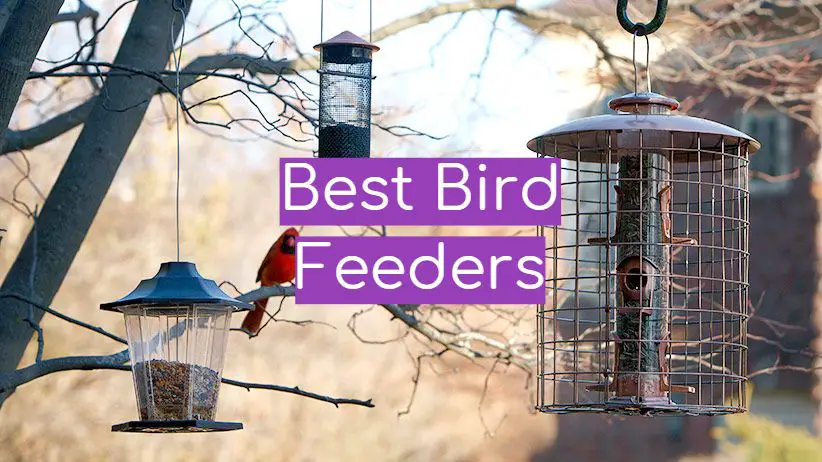

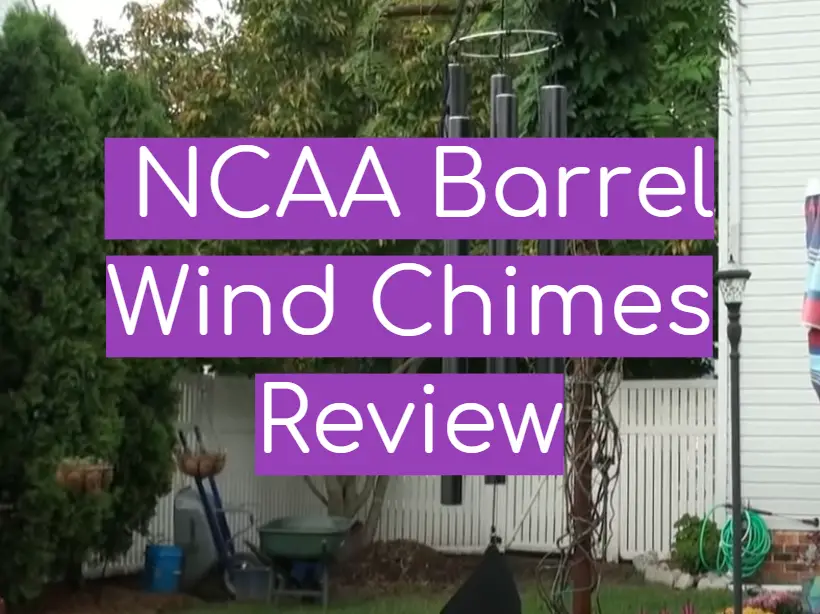
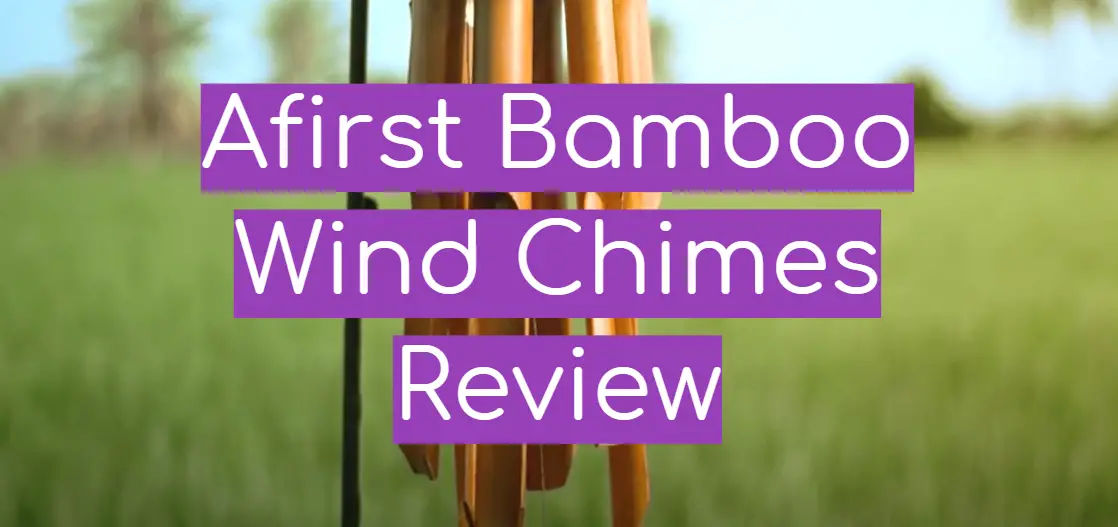
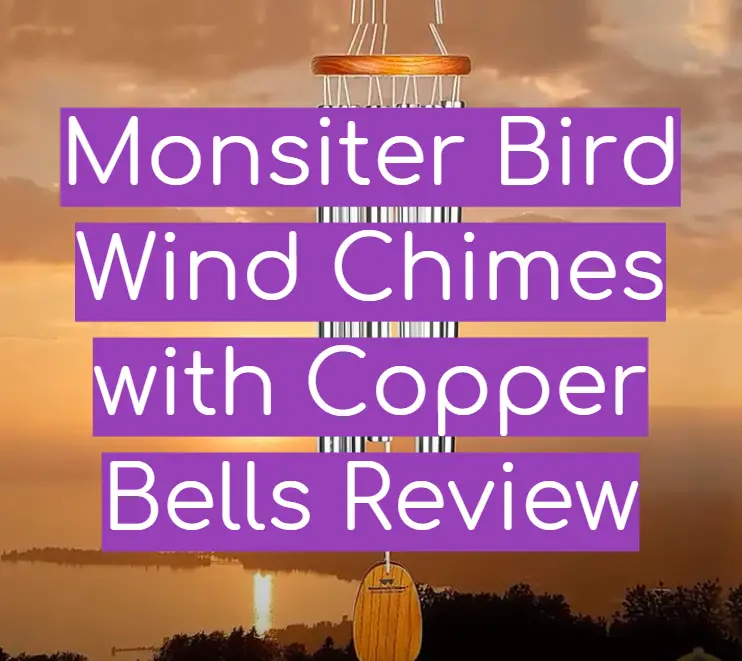
Leave a Reply